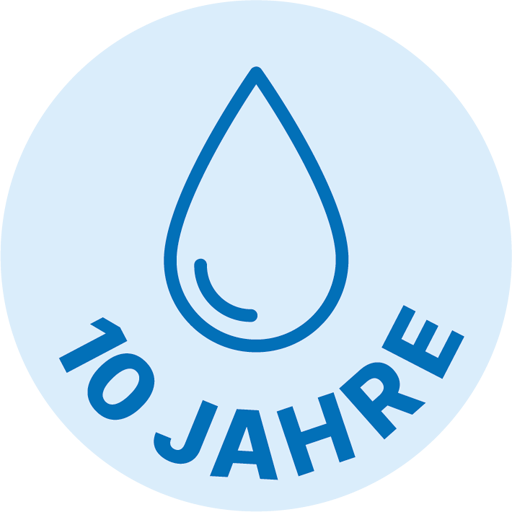Since we manufacture limescale protection devices and consider ourselves experts in our field, we decided to make an in-depth comparison of limescale protection devices vs. descaling systems (salt) to highlight the key differences between them.
Let’s take a look at how limescale protection devices and descaling systems compare in the following categories:
- Acquisition and installation costs
- Operating costs
- Drinking water quality
- Influence on health
Acquisition and installation costs
Limescale protection unit: Depending on the living space, Tratson offers a choice of two limescale protection appliances for single-family homes: ENK-01 Quattro Power (up to approx. 180m2 living space) at a price of CHF 1,558 and the ENK-02 Quattro Power (from 180m2 – approx. 300m2 living space) at a price of CHF 1,766.
The installation of a limescale protection device is very simple and is carried out by around 70% of ambitious homeowners themselves.
However, if a specialist is required to carry out the installation, this is done at a flat rate of CHF 260.
Descaling system: The price of a descaling system for a detached house is somewhere between CHF 1,000 and CHF 4,000.
The wide price range between the different products is mainly due to the size of the resin cartridge.
The larger the resin cartridge, the higher the price.
If you opt for a smaller device, the price will be lower, but this device will have to be regenerated much more frequently.
This will result in higher running costs for the salt required for regeneration, as well as higher fresh water and waste water costs.
In the medium to long term, the money saved by the lower purchase price will be offset by the higher running costs.
The water pipe must be disconnected for the installation of a descaling system.
For all water installations that are in direct contact with water, a trained specialist (plumber) must be consulted who has the appropriate authorization (concession) from the water supply company.
Self-installation by the owner is therefore not permitted.
Depending on the work involved, these costs amount to a further CHF 500 – 1,500.
The installation location of a descaling system must not be in a heated room such as the boiler room or laundry room due to increased germ formation.
Conclusion: A limescale protection device is generally a more cost-effective purchase than a descaling system, especially if the installation of the limescale protection device can be carried out by the user.
Operating costs
Limescale protection device: The only operating costs are the electricity costs, which are around CHF 10 – 20 per year.
No service or maintenance is required.
The average service life of a limescale protection device is 20 years.
The new purchase costs are therefore CHF 87 per year.
The service life of our products is designed for at least 20 years.
All our products are guaranteed for 10 years.
Descaling system: Salt must be added to the descaling system for regeneration.
Salt is available in large 25 kg bags and costs around CHF 15 per bag.
The annual costs for salt and its procurement are between approx. 40 – 100 CHF.
For regeneration, a decalcification system requires additional fresh water and produces the same amount of waste water, which has to be cleaned again by the wastewater treatment plants.
During regeneration, the descaling system offers no protection against limescale.
We estimate the costs for this at around CHF 20 – 40 per year.
The descaling system also requires electricity, which also costs around CHF 10 – 20 per year.
Due to the increased risk of germ formation, the descaling system should be serviced annually by a specialist.
The maintenance costs can vary greatly depending on the route and duration.
An average value is approx. 150 CHF/year.
The average service life of a descaling system is 10 years.
The new acquisition costs are therefore approx. 280 CHF/year.
The service life of most descaling systems is designed for 10 years.
The warranty depends on the manufacturer and is usually only valid for 2 years.
Conclusion: The operating costs for a limescale protection device are significantly lower than for a descaling system.
Drinking water
Limescale protection device: The composition of the drinking water remains unchanged.
The taste may even improve.
Decalcification system: The calcium ions have been replaced by sodium ions.
The drinking water is enriched with sodium and must not exceed the maximum limit of 200 mg/liter.
For small children and senior citizens, the guideline value is 20 mg/liter.
Calcium is a natural flavor carrier in water, which is why replacing it with sodium can give the water an unfamiliar, strange taste.
Sodium with chloride makes drinking water taste salty.
Conclusion: With a limescale protection device, you maintain the desired quality.
With a descaling system, this is generally impaired.
Health
Limescale protection device: You can continue to enjoy your usual, healthy and mineral-rich drinking water.
Decalcification system: As a large proportion of the calcium in drinking water has been replaced by sodium, daily consumption can lead to excess sodium in the body.
Due to possible contamination, drinking water can be infested with a variety of bacteria, viruses and fungi that are invisible to the naked eye.
Advantages of our limescale protection device
You can find out more about our limescale protection devices – and the convincing reasons why they are the better choice – on the following pages:

